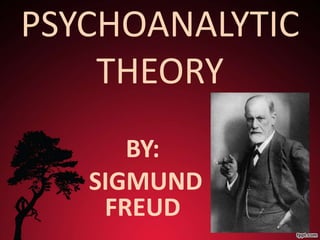This document provides an overview of Sigmund Freud's psychoanalytic theory. It begins with biographical details of Freud, who founded psychoanalysis. Psychoanalysis views human nature as deterministic and driven by unconscious motivations and instincts. Freud believed the mind has three levels - unconscious, preconscious, and conscious. He proposed that personality has three structures - the id, ego, and superego. Freud also developed psychoanalytic therapy techniques including free association, dream analysis, analysis of resistance and transference. The goal of therapy is to make the unconscious conscious to help clients gain insight and strengthen their ego.















































